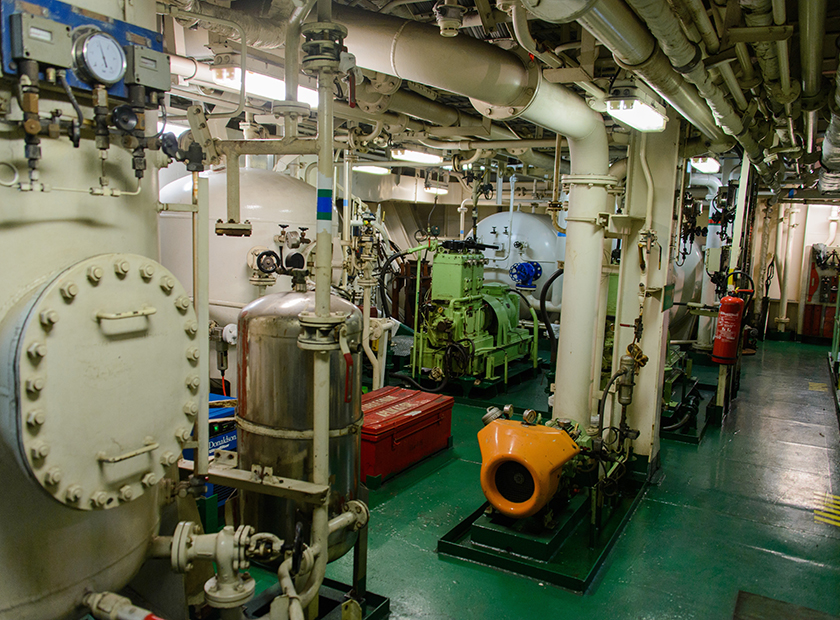Overview
United States Coast Guard (USCG) announced the execution of an Enhanced Examination Program (EEP) on Engine Room Fire Safety. The USCG EEPs are similar to Concentrated Inspection Campaigns (CiC) conducted by other PSC regimes.
Period of extra inspections: 1 April 2024 – 30 June 2024.
Background
During this period of extra scrutiny USCG Port State Control (PSC) Officers have been directed to carry-out an enhanced examination to verify engine room fire safety. The enhanced examination will take place during every USCG PSC A and PSC B inspection conducted onboard cargo ships.
The USCG PSC team will:
- Verify proper operation of at least one (1) fuel oil shutoff valve via remote operation. {SOLAS 11-2/4.2.2.3.4)
- Verify proper operation of control of stopping power ventilation for machinery spaces from outside the machinery space. (SOLAS 11-2/5.2.1.2)
- Verify presence and condition of protection against hot surfaces (i.e., lagging). {SOLAS 11-2/26.1)
During the EEP examination USCG PSCOs have been instructed not to test operation of fuel oil shutoff valves which would affect current operation of a ship’s machinery, to ensure that engines are not starved of fuel. If available engine room fuel oil shutoff valves cannot be operationally tested without affecting engine or ship operations, PSCOs shall visually examine the material condition of each valve, but not instruct the ship’s crew to carry out operational testing.
Just for clarification:
- PSCA A is a more detailed PSC Inspection with increased scope beyond a standard exam, to include operational tests of equipment and witnessing crew performance of drills.
- PSC B is the standard exam which includes a document check with a deck and engine room walk to verify validity of the ship’s certificates. Limited operational tests of equipment and systems may also be conducted. However, the PSCO may expand the scope of the exam, to include additional equipment tests and/or witness drills.
Actions required
Ship owners/managers should be prepared for above inspections even if their managed ships are not eligible for a normal PSC inspection. Crew on board prior entering a US Port should (additionally to other preparations):
- verify operation of remote and local control of fuel oil shutoff valves
- verify functionality of power ventilation stopping arrangements
- inspect lagging in engine rooms and other machinery spaces to ensure appropriate protection is provided against hot surfaces (and ensure lagging is not contaminated with oil).
- ensure there are no leakages from machinery in engine room (oil accumulation in engine room)
- ensure the Engine room is clean and tidy.
How we may help
RiSK4SEA platform (risk4sea.com) can be used for PSC preparation for all ports world wide.
Appendix A: Items to be checked for engine room& Associated spaces
Deficiency Description
|
Code |
Most Common USCG PSCO findings (grouped) |
| Remote Means of control (opening, pumps, ventilation, etc.) Machinery spaces |
07114 |
- A number of quick closing valves failed to close from remote location.
- A high percentage of the automatic closure devices didn’t operated when tested.
- PSCO observed zero pressure in the air tank for the quick closing valves for the fuel system. Valves from the compressor air system was opened and a leak was identified
- Quick-closing valves for HFO fuel tanks in the engine room were completely disconnected from the pneumatic closing system and thus preventing proper operation
- There were wood blocks observed that would prevent the valve from operating.
- Remote quick closing fuel valve to emergency generator fuel tank was not completely set and not functioning from the remote pull station outside the space.
- Ship continued to utilize HFO with the metal blocking piece in place until switching over to low sulfur fuel. In the event of an engine room fire, the quick closing valve would not be able to fully close as designed and HFO would continue to be supplied potentially supporting the fire in the space. The remote actuator for the valve would be ineffective.
- The emergency fuel shutoff valve wrench is missing from fuel shutoff location rendering the remote fuel shutoff inoperable
- Fire main suction valve position indicator was found corroded and disconnected.
- During operational testing as part of witnessing, the air conditioning unit in ECR failed to stop when relevant external button was pushed
- Outboard fuel oil shutoff valves on both port and starboard sides do not close completely when operated remotely
|
| Ventilation |
07116 |
- Emergency generator and steering gear room ventilation outlets located starboard side aft deck have wastage in the steel and cannot be operated remotely.
- Ventilation in engine room workshop would not close and does not prevent passage of smoke and hot gases.
- Vent dampers closures had no indication as to if the vent/damper is open or closed.
- PSCO observed electrical cable passing through an “A” class divisions into the emergency generator room leaving openings in the boundary.
- The vent to Engine workshop was zip tied in the closed position. No air flow was sweeping over the valve unit or through the room.
- Both ventilation dampers were unable to be secured from inside or outside the engine room.
- Main propulsion ventilation damper found to have holes corroded on the bottom of the vent enclosures.
|
| Oil accumulation in engine room |
07126 |
- PSCO observed accumulations of hydraulic oil around cylinder heads due to loose hydraulic line connections.
- Leaking seal on fuel oil transfer pump leading to a plastic container.
- Excessive oil leakages on the engine room and purifier room operating equipment
- Fuel oil leaks on number of generators’ and ME fuel supply line
- PSCO discovered a funnel and drip channel constructed with gasket material between cylinders on the Main Diesel Eng collecting oil into a bucket from unidentified oil leakage.
- PSCO observed fuel oil and water mixture under oil purifiers.
- Oily rags wetted in fuel oil found under engine room machinery
|
| Protection machines/parts |
09218 |
- Ventilation screen in the lower engine room found broken
- Hot surface of exhaust on generator was missing insulation
- Exhaust piping in vicinity of turbo charger showed signs of excess heat which poses a fire risk
- Lagging for the piping on diesel generators was worn and missing in some areas
|
| Pipes, wires (insulation) |
09219 |
- The material condition of lagging in the incinerator, fuel purifying, and engine room was degraded and missing.
- PSCO observed missing lagging from ship service diesel generator exhaust piping.
- M/E fuel oil drain lines were missing lagging or lagging was deteriorated.
- PSCO observed oil soaked lagging in purifier room and on piping to the main engine
|
| Insulation wetted through (oil) |
13106 |
- PSCO observed missing lagging on the ship service diesel generator’s turbo charger and exhaust connections.
- Fuel supply line to main engine found to be soaked with fuel to include high pressure relief valves.
- Oil-soaked lagging found in the vicinity of cylinders on the main engine steam fire extinguisher line.
- PSCO observed areas of oil-soaked lagging of the heavy fuel oil piping in the purifier room and adjacent machinery space, indicating potential leaks in the piping system.
- Lagging is visibly worn and exposes steam lines in Engine Room
- PSCO observed lagging on the fuel pipes saturated with oil throughout the Engine Room creating a fire hazard.
|
Interested to receive Port Call Risk Assessment to prepare your ship for the forthcoming port call?


